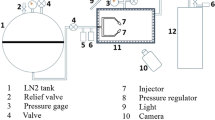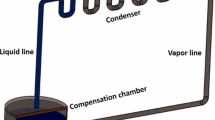Abstract
In this research, molecular dynamics simulations of water nanojet ejection out of nozzle holes with various sizes under various pressing forces are performed. The water molecules are ejected out the nozzle by a back plate on which a constant force is applied. The results of MD simulations of water ejection show that after one ejection, about 1.3–2.5% of total molecules accumulate on the nozzle plate surface. These molecules affect the ejection of water jet thereafter. The cause of the accumulation of wetting water is investigated by analyzing the trajectories of these molecules. It is found that in the firing chamber near the nozzle plate wall, the arrangement of water molecules is aligned by the surface topology of the metal wall. Water molecules are packed into filamentous structure and these lines stack up at equal distances to each other. Water molecules drift along these lines, the trajectories of these molecules are sinuous, the velocity directions of them are random; molecules drift along the parallel lines until they reach a region of low pressure beneath the nozzle opening. These molecules eject out through the edge of the nozzle, they fall back on to the nozzle surface and eventually deposit on the nozzle surface due to low ejection velocity.















Similar content being viewed by others
References
Asai A (1992) Three-dimensional calculation of bubble growth and drop ejection in a bubble jet printer. ASME J Fluids Eng 114:638–641
Choi YS et al (2006) Molecular dynamics of unstable motions and capillary instability in liquid nanojets. Phys Rev E 73:016309
Dou Y et al (2001) Explosive boiling of water films adjacent to heated surfaces: a microscopic description. J Phys Chem A 105:2748–2755
Dou Y et al (2003) Substrate-assisted laser-initiated ejection of proteins embedded in water films. J Phys Chem B 107:2362–2365
Fan X et al (2002) Molecular dynamics simulation of a liquid in a complex nano channel flow. Phys Fluids 14:1146–1153
Huang C et al (2007) A modified Schlieren technique for micro flow visualization. Meas Sci Technol 18:n32
Ibrahim M et al (2006) Inkjet printing resolution study for multi-material rapid prototyping. JSME Int J Ser C 49:353–360
Kondic L (2009) Nanoparticle assembly via the dewetting of patterned thin metal lines: understanding the instability mechanisms. Phys Rev E 79:026302
Levitt M et al (1997) Calibration and testing of a water model for simulation of the molecular dynamics of proteins and nucleic acids in solution. J Phys Chem B 101:5051–5061
Lin JW, Chu SX (2008) Molecules dynamics simulation of nanoscale water jet. Proceeding of NMHT 2008, NMHT 2008 52044
Meinhart CD, Zhang HJ (2000) The flow structure inside a microfabricated inkjet printhead. Microelectromechanical System 9:67–75
Morse M, Landman U (2000) Formation, stability and breakup of nanojets. Science 289:1165–1169
Murad S, Puri IK (2007) Dynamic of nanoscale jet formation and impingement on flat surfaces. Phys Fluids 19:128102
Rembe C et al (2000) Thermal ink jet dynamics: modeling, simulation and testing. Microelectron Reliab 40:525–532
Shin DY et al (2005) Oscillatory incompressible fluid flow in a tapered tube with a free surface in an inkjet print head. ASME J Fluids Eng 127:98–109
Steinert CP et al (2004) A highly parallel picoliter dispenser with an integrated, novel capillary channel structure. Sens Actuators A 116:171–177
Wereley ST et al (2007) Advanced algorithms for microscale velocimetry. AIAA J 40:1047–1055
Zhang HW et al (2007) Pressure control model for transport of liquid mercury in carbon nanotubes. Appl Phys Lett 90:144105
Author information
Authors and Affiliations
Corresponding author
Rights and permissions
About this article
Cite this article
Lin, JW. Studying on water nanojet ejection and the wetting phenomena on the nozzle surface. Microfluid Nanofluid 13, 37–48 (2012). https://doi.org/10.1007/s10404-012-0938-2
Received:
Accepted:
Published:
Issue Date:
DOI: https://doi.org/10.1007/s10404-012-0938-2




